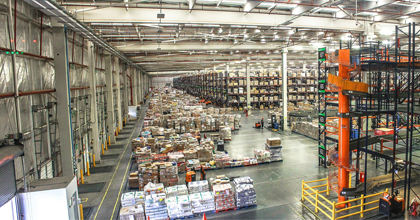Mechanism behind the sharp increase in packages for home delivery

What caused this serious shortage of delivery drivers? It is said that one of the causes is the rapid growth of online shopping. It is fairly certain that our opportunities for online shopping have been significantly increasing lately. This could be attributed to our busy lives and our lack of time for housework. The proportion of working women has also increased and it has become difficult to make enough time to actually go to the store to shop. So, the utilization of online shopping sites, which are so convenient and make shopping possible at any time using a smartphone or a PC, has been increasing rapidly. With the additional shortage of delivery drivers though, deliveries have become unable to keep up with sales.
Now let us think about the mechanism behind the rapid growth of online shopping. Online shopping sites are a combination of a virtual shop and a delivery network. Consumers can save time by covering their time cost and transportation cost to go shopping in actual stores with the delivery charges. Meanwhile, Internet mail-order companies take these delivery charges paid by the consumers and use them to pay shipping charges to the home delivery companies or to recover the costs for their distribution bases which they have capitalized themselves. On the other hand, Internet mail-order companies fulfill an assortment of products in their virtual shops by procuring (producing) products on their own or by getting virtual tenants to open a store. On this occasion, if the delivery charges to be paid by the consumers are actually paid by the mail-order company as “free shipping,” the consumers’ overall shopping costs would be reduced, and the shopping site would see an increase in users. With an increase in users, the shopping site would become more attractive, and the number of tenants and suppliers wanting to do business on the site would increase. Companies providing an online shopping platform could get benefits which far surpass the cost of “free shipping” from the increasing income they receive from their tenants, lower purchase prices, advantageous payment terms, etc. In addition, their selection would increasingly expand as part of the rapid growth process, and the site would become even more attractive to consumers. This is why the number of packages for home delivery has been increasing sharply.
Structural “distortion” of recipients and service providers
It has been pointed out that the background for this distribution capacity that cannot keep up with such a sharp increase in distribution demand is the distortion in the distribution cost payment structure. In other words, the level of fees paid to logistics companies is too low and it is necessary to raise shipping charges. Actually, distribution demand is increasing, while shipping charge levels are on a downward trend. Until this is rectified, the young workforce will not enter the logistics industry. So, negotiations for a rise in shipping charges between logistics companies and the shippers are now in progress. In addition, consumers’ proper payment of delivery charges may ease the above-mentioned excessive surge in online shopping packages. However, it seems that the essence of this lies in the structural “distortion” of recipients and service providers in this country. The wrong idea that “service is free of charge” seems to be deeply seated in our consciousness. Although the above-mentioned “free shipping” also tends to be taken for granted for some reason, because shopping costs which should normally be paid by consumers are just “outsourced” to the home delivery companies as a service, the users or recipients should pay fairly for this service.
More specifically, service is “produced” through cooperation between providers and recipients. For example, with a barber service, a visitor cannot get their expected haircut until they visit a barbershop and make the appropriate order. Also with a home delivery service, a system needs to be devised for the recipients to somehow “cooperate” in the receipt process. In other words, not just the payment of charges but the distorted structure in which the providers and the recipients of the logistics service are divided is the more fundamental problem. Therefore, it is essential to connect the two to maintain and improve a high level of service.
Trial system creation

Some measures against the distribution crisis are currently being trialed. Yamato Transport Co., Ltd. has built a high-density network known as Field Cast, in which local housewives are organized to make small deliveries during times of peak delivery demand. As measures against absence, delivery boxes have been installed in stations while you can also choose to receive their goods at a convenience store. A service which allows you to receive your package at another preferred place except your home using a smartphone is also in its trial stage and it is said that these delivery trucks could become driverless in the future. In distribution applications other than home delivery, a reservation system has been introduced in some cases in order to reduce truck waiting times for receipt and discharge at distribution centers. For trunk road transport, convoy travel of trailer trucks is now in the testing stage and utilization of the railways is also being promoted. A transport matching system, in which the containers piled up at port are laid down beginning at the top and the trucks to be loaded with them are identified online in order to speed up port loading and unloading, is already in operation abroad. In light of these developments, a real-time matching system for demanders and providers of distribution service utilizing IT seems to be effective. In addition, a system which can flexibly respond to any changing situations while monitoring the process of such service, and make accurate forecasts utilizing the mass of monitoring information will also be utilized.
Logistics to realize shared values in society
In future society, a business that solves common problems for the community through the best use of limited resources will be required. This is known as Creating Shared Value (CSV). To realize CSV, innovations around the flexible combination and systematization of our capacities, human resources, and space and time available in the community, as managerial resources, must be made to happen. Logistics originally means a preparation system for a certain purpose. For our future society, it will be necessary to continue to utilize our human resources, energy resources and physical resources as long as possible, effectively and at a high level, respecting all of them and harmonizing them with the natural environment. In an aging society, a globally high-level home delivery service will play an increasingly important role. To maintain such a convenient society for many years to come, the time has come for us to overcome the structure in which the providers and recipients of a service or consumers and workers are divided, and rethink what role we should play and how we should continue to function, as “citizens” who can continue to support the community.
* The information contained herein is current as of July 2017.
* The contents of articles on M’s Opinion are based on the personal ideas and opinions of the author and do not indicate the official opinion of Meiji University.
Information noted in the articles and videos, such as positions and affiliations, are current at the time of production.


